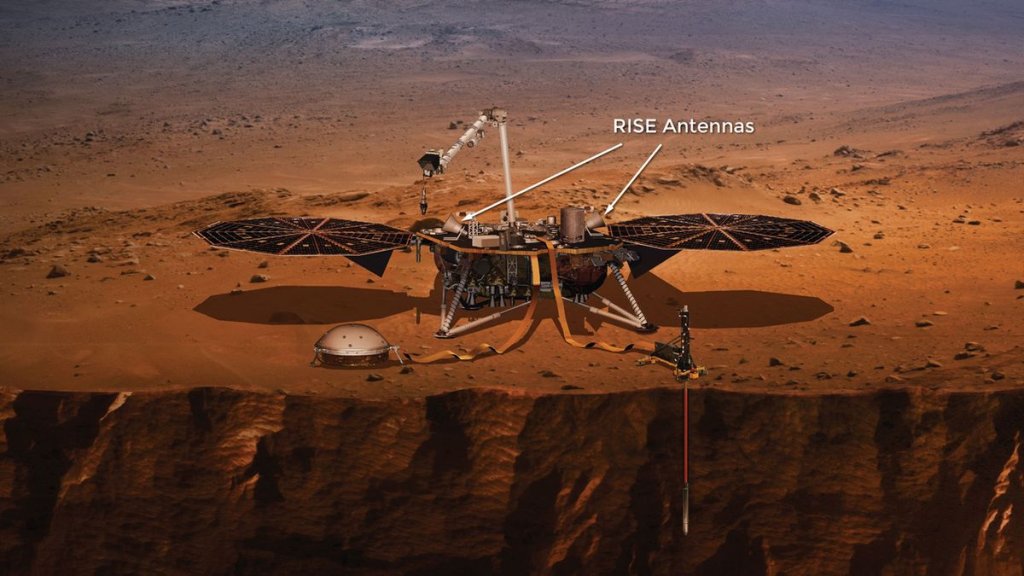The length of Mars’ day is shortening by three-quarters of a millisecond each year as the planet’s rotation spins up, according to new results from NASA’s InSight lander.
A standard day on Mars, or “sol” as it is called, is 24 hours and 37 minutes long, but measuring that length of day to an accuracy of a fraction of a millisecond has revealed the planet’s rotation rate is speeding up by a tiny amount. Planetary scientists are not entirely sure why this is happening, but it is likely related to the redistribution of Mars’ mass, which can have an effect on the planet’s rotation like an ice skater pulling in their arms to spin faster. This redistribution might be caused by the accumulation of ice on Mars’ polar caps, experts believe, or by the surface itself slowly rebounding from residing under the weight of immense glaciers that existed at equatorial latitudes during the world’s most recent ice ages, which ended about 400,000 years ago.
To get these incredibly precise measurements of Mars’ rotation rate, the study scientists utilized radio waves.
“It’s a historic experiment,” Sebastien Le Maistre, a planetary scientist at the Royal Observatory of Belgium and lead author of a new paper on the findings, said in a statement. “We have spent a lot of time and energy preparing for the experiment and anticipating these discoveries.”
Related: Scientists hail scientific legacy of NASA’s Mars InSight lander
A powerful radio signal was blasted towards Mars by NASA’s Deep Space Network, composed of three radio antennas around the world that are employed for communicating with interplanetary missions. The radio signal was then received by InSight’s RISE (Rotation and Interior Structure Experiment) instrument and reflected back to Earth. Mars’ spin adds a Doppler shift to these reflected radio waves.
The Doppler shift is the same effect that causes the siren of an emergency vehicle to rise in pitch as it approaches a listener before dropping again as it moves away. Similarly, when InSight is on the hemisphere of Mars that is rotating into view, the radio signal it emits is Doppler shifted to higher frequencies, and when InSight is on the hemisphere rotating out of view, the signal is Doppler shifted to shorter frequencies. This Doppler shift is entirely dependent upon the rate of rotation, and harnessing it to measure the planet’s length of day – to an accuracy of fractions of a millisecond – isn’t a simple task.
“What we’re looking for are variations that are just a few tens of centimeters over the course of a Martian year [687 Earth days],” said Le Maistre, who is also RISE’s principal investigator. “It takes a very long time and a lot of data to accumulate before we can even see these variations.”
The experiment used data from InSight’s first 900 days on Mars, and concluded that Mars’ rotation is speeding up by 0.76 milliseconds per year – the most precise measurement of Mars’ rotation period ever made.
The core of Mars
RISE has also been doing work on the interior of the red planet, measuring the size of Mars’ molten core.
Though the planet’s core is inaccessible to direct observation, scientists can measure the size and probable state of Mars’ mantle and core by tracking how the radio data from RISE changes as Mars wobbles on its axis. This wobble is the result of molten iron in the core sloshing about. Previously, InSight had already ascertained that Mars’ core is on the large side, using seismic waves from marsquakes that ripple through the planet. Now, RISE has been able to refine that measurement.
The interior of Mars, like Earth, is differentiated into different layers.
There is the crust, on which the surface sits. Beneath that is the mantle, which on Earth contains molten magma but on Mars is assumed to be completely solid. That’s because it’s expected to have cooled as heat leaked away faster than it does on Earth, which is larger in size. Beneath the mantle is a metallic molten core of liquid iron – and it’s the size of this molten core that Le Maistre’s team measured with RISE.
RISE data implied that Mars’ molten core has a diameter of 2,280 miles (3,670 kilometers). This can be compared to Mars as a whole, which has a diameter of 4,212 miles (6,779 kilometers). However, there is a caveat. If the mantle is not totally solid, and is actually molten at the bottom, that molten part would rotates independently of the solid part. This would mean that the core could be up to 400 kilometers smaller than RISE data suggests.
The RISE data also found that the core is not perfectly spherical, but is lumpy, with what Le Maistre’s team describe as “internal mass anomalies.”
“RISE’s data indicate the core’s shape cannot be explained by its rotation alone,” Attilo Rivoldini of the Royal Observatory of Belgium, said in the statement. “That shape requires regions of slightly higher or lower density buried deep within the mantle.”
InSight (its name is short for Interior Exploration using Seismic Investigations, Geodesy and Heat Transport) ran out of power and ended its mission in December 2022, but there is still plenty of data from the mission, and from RISE in particular, to analyze.
These results were published in June in the journal Nature.

